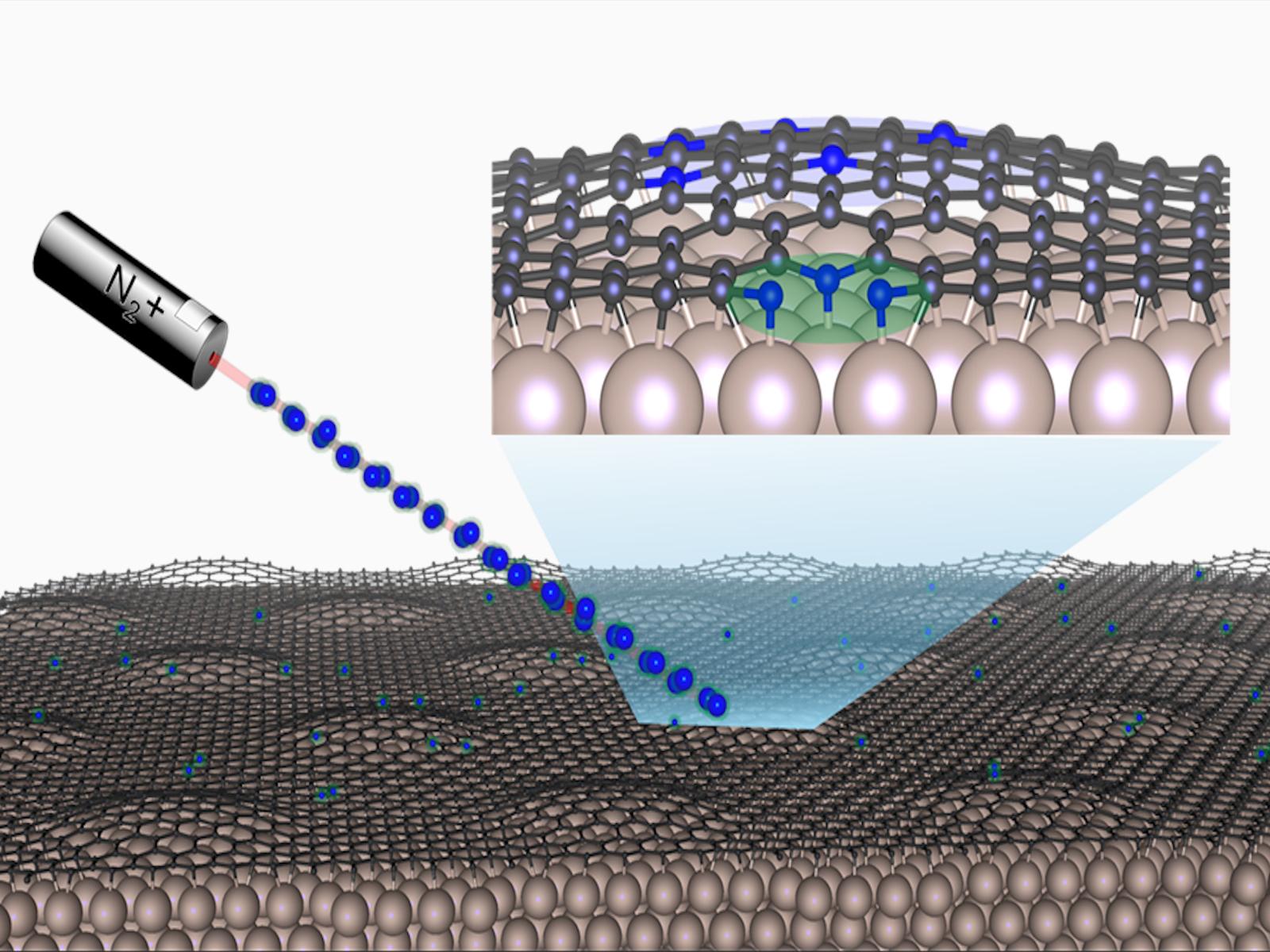Understanding and Controlling Nitrogen Speciation in Doped Graphene
The ruthenium metal support affects the formation and stability of graphitic and pyridinic nitrogen in doped graphene

A combination of microscopy and modeling enables researchers to investigate the role of the support in controlling the location of pyridinic and graphitic nitrogen in graphene on ruthenium.
(Image by Peter Rice and Zbynek Novotny | Pacific Northwest National Laboratory)
The Science
Graphene-like materials have attracted research interest for large-scale hydrogen storage applications because they are lightweight, durable, and scalable. Doping these materials with nitrogen can affect their chemical properties. Researchers prepared nitrogen-doped graphene samples and were able to tune the concentration and distribution of the two types of nitrogen sites—graphitic (GN) and pyridinic (PN). The GN sites were more stable than the PN sites in the system, leading to different location preferences for the nitrogen sites. The team identified the primary factor driving nitrogen location as the metal–nitrogen distance rather than graphene curvature.
The Impact
Controlling the type and distribution of defects in materials is important because they directly affect the final material properties. Because hydrogen can exist in three charge states (H+, H0, and H-), understanding how hydrogen interacts with these defects opens an avenue for spatially resolved control of doping, which can control overall material functions. By identifying the key parameters that control nitrogen doping in metal-supported graphene, researchers can more effectively control how hydrogen adsorbs, dissociates, and moves on these materials. This enhanced control can lead to improved approaches to hydrogen energy storage.
Summary
Controlling the identity of doping sites, their coordination environment, and their spatial distribution in graphene and related 2-D materials is critical to tailoring these materials for hydrogen storage applications. Researchers investigated nitrogen doping in graphene on a ruthenium support using nitrogen ion implantation followed by annealing. This method allowed them to successfully tune the concentration and distribution of GN and PN sites. Through a combination of scanning tunneling microscopy imaging, x-ray photoelectron spectroscopy characterization, and theoretical calculations, the team identified the structure and spatial distribution of GN and PN species. They developed a thermodynamic phase diagram, which shows the relative stabilities of GN and PN across graphene. GN was the most stable in regions furthest from the metal, while PN was more stable at the edges between regions where the graphene was closest to the metal. The metal support has a key effect on nitrogen speciation, overshadowing graphene curvature.
Contact
Zbynek Novotny, Pacific Northwest National Laboratory, zbynek.novotny@pnnl.gov
Tom Autrey, Pacific Northwest National Laboratory, tom.autrey@pnnl.gov
Funding
This work was performed at Pacific Northwest National Laboratory (PNNL) and supported by the U.S. Department of Energy, Office of Science, Basic Energy Sciences, Materials Sciences and Engineering Division, Physical Behavior of Materials Program, FWP 80110. Part of this work (results shown in Figure S1d, by DB and MAS) acknowledges support from the U.S. Department of Energy, Office of Science, Basic Energy Sciences, Chemical Sciences, Geosciences, and Biosciences Division, Catalysis Science Program, FWP 47319. PNNL is operated by Battelle for the U.S. Department of Energy under Contract No. DE-AC05-76RL01830. This research used resources of the National Energy Research Scientific Computing Center (NERSC), a U.S. Department of Energy, Office of Science user facility located at Lawrence Berkeley National Laboratory, operated under Contract No. DEAC02- 05CH11231.
Published: August 21, 2025
Buddhika S. A. Gedara, Peter S. Rice, Prescott E. Evans, Daniel Baranowski, Marcus A. Sharp, Tom Autrey, Bojana Ginovska, Zdenek Dohnálek, Zbynek Novotny. “Thermodynamic stability and site-specific distribution of graphitic and pyridinic nitrogen in graphene moiré on Ru(0001),” Advanced Materials Interfaces, 2500142 (2025). [DOI: 10.1002/admi.202500142]